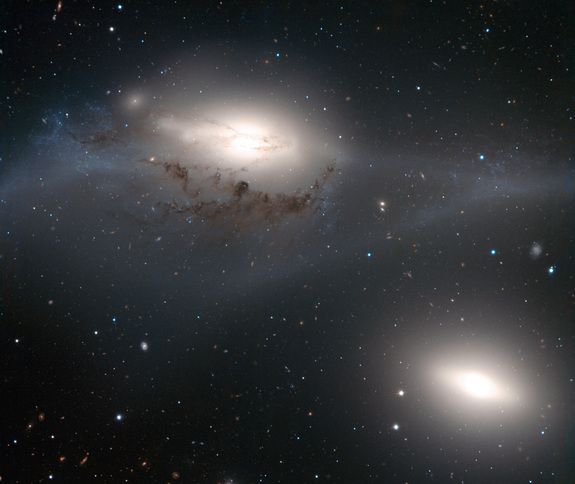Striking Photo Looks Into the 'Eyes' of Cosmic Virgin

A spectacular new photo from an observatory in Chile has snapped a spectacular photo of two peculiar galaxies that scientists call "The Eyes."
The new photo, released today (Aug. 24), shows a view of the Eyes from the European Southern Observatory's Very Large Telescope.
The Eyes are about 50 million light-years away in the constellation of Virgo (The Virgin) and are some 100,000 light-years apart. The cores of the two galaxies are bright white ovals that resemble a pair of eyes glowing in the dark when seen in a moderate-sized telescope, ESO officials said. [See the stunning Eyes galaxy photo]
Two eyes in the dark
The larger of The Eyes, NGC 4438, was once a spiral galaxy but has become badly deformed by collisions with other galaxies in the last few hundred million years.
The outskirts of the galaxies are as different as the cores are similar. The second galaxy "eye" in the lower right (NGC 4435) is compact and seems to be almost devoid of gas and dust, according to an ESO description. The other galaxy, NGC 4438 in the upper left, has a lane of dust just below its nucleus, young stars left of its center and gas at least up to the edges of the image.
The contents of NGC 4438 have been stripped out by a violent process: a collision with another galaxy.
Sign up for the Live Science daily newsletter now
Get the world’s most fascinating discoveries delivered straight to your inbox.
This clash has distorted the galaxy's spiral shape, much as could happen to the Milky Way when it collides with its neighboring galaxy Andromeda in three or four billion years.
NGC 4435 could be the culprit, ESO officials said.
Some astronomers suspect that the damage caused to NGC 4438 resulted from an approach between the two galaxies to within about 16,000 light-years that happened some 100 million years ago. But while the larger galaxy was damaged, the smaller one was significantly more affected by the collision. [Video: The Galactic Eyes of Virgo]
Gravitational tides from this clash are probably responsible for ripping away the contents of NGC 4438, and for reducing NGC 4435's mass and removing most of its gas and dust.
A galactic intruder?
Another possibility is that the giant elliptical galaxy Messier 86, further away from The Eyes and not visible in this image, was responsible for the damage caused to NGC 4438. Recent observations have found filaments of ionized hydrogen gas connecting the two large galaxies, indicating that they may have collided in the past.
The elliptical galaxy Messier 86 and The Eyes belong to the Virgo Cluster, a very rich grouping of galaxies. In such close quarters, galaxy collisions are fairly frequent, so perhaps NGC 4438 suffered from encounters with both NGC 4435 and Messier 86.
This picture is the first to come out of ESO's Cosmic Gems program, an initiative to produce astronomical images for educational and public outreach purposes.
This story was provided by SPACE.com, sister site to LiveScience.com. Follow SPACE.com for the latest in space science and exploration news on Twitter @Spacedotcom and on Facebook.













